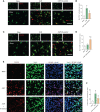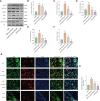Sestrin2 provides cerebral protection through activation of Nrf2 signaling in microglia following subarachnoid hemorrhage
- PMID: 36761756
- PMCID: PMC9903076
- DOI: 10.3389/fimmu.2023.1089576
Sestrin2 provides cerebral protection through activation of Nrf2 signaling in microglia following subarachnoid hemorrhage
Abstract
Subarachnoid hemorrhage (SAH) is a neurological emergency characterized by dysfunctional inflammatory response. However, no effective therapeutic options have been reported so far. Microglia polarization has been proposed to exert an essential role in modulating inflammatory response after SAH. Sestrin2 is a stress response protein. Growing evidence has reported that sestrin2 could inhibit M1 microglia and promote M2 microglia polarization. The current study investigated the effects of sestrin2 on microglia phenotype switching and the subsequent brain injury and sought to elucidate the underlying mechanism. We conducted an endovascular perforation SAH model in mice. It was found that sestrin2 was significantly increased after SAH and was mainly distributed in neurons and microglia. Exogenous recombinant human sestrin2 (rh-sestrin2) evidently alleviated inflammatory insults and oxidative stress, and improved neurofunction after SAH. Moreover, rh-sestrin2 increased M2-like microglia polarization and suppressed the number of M1-like microglia after SAH. The protection by rh-sestrin2 was correlated with the activation of Nrf2 signaling. Nrf2 inhibition by ML385 abated the cerebroprotective effects of rh-sestrin2 against SAH and further manifested M1 microglia polarization. In conclusion, promoting microglia polarization from the M1 to M2 phenotype and inducing Nrf2 signaling might be the major mechanism by which sestrin2 protects against SAH insults. Sestrin2 might be a new molecular target for treating SAH.
Keywords: Nrf2; microglial polarization; neuroinflammation; sestrin2; subarachnoid hemorrhage.
Copyright © 2023 Yang, Ding, Yang, Wu, Bao, Lan, Zhou, Zhou, Liu, Hong, Wan and Wu.
Conflict of interest statement
The authors declare that the research was conducted in the absence of any commercial or financial relationships that could be construed as a potential conflict of interest.
Figures







Similar articles
-
Nrf2 activation by neferine mitigates microglial neuroinflammation after subarachnoid hemorrhage through inhibiting TAK1-NF-κB signaling.Int Immunopharmacol. 2024 Mar 30;130:111693. doi: 10.1016/j.intimp.2024.111693. Epub 2024 Mar 1. Int Immunopharmacol. 2024. PMID: 38428144
-
Propofol alleviates M1 polarization and neuroinflammation of microglia in a subarachnoid hemorrhage model in vitro, by targeting the miR-140-5p/TREM-1/NF-κB signaling axis.Eur J Histochem. 2024 Sep 17;68(3):4034. doi: 10.4081/ejh.2024.4034. Eur J Histochem. 2024. PMID: 39287134 Free PMC article.
-
Erythropoietin ameliorates early brain injury after subarachnoid haemorrhage by modulating microglia polarization via the EPOR/JAK2-STAT3 pathway.Exp Cell Res. 2017 Dec 15;361(2):342-352. doi: 10.1016/j.yexcr.2017.11.002. Epub 2017 Nov 2. Exp Cell Res. 2017. PMID: 29102603
-
Sestrin2 Signaling Pathway Regulates Podocyte Biology and Protects against Diabetic Nephropathy.J Diabetes Res. 2023 Feb 10;2023:8776878. doi: 10.1155/2023/8776878. eCollection 2023. J Diabetes Res. 2023. PMID: 36818747 Free PMC article. Review.
-
Neuroprotective Role of the Nrf2 Pathway in Subarachnoid Haemorrhage and Its Therapeutic Potential.Oxid Med Cell Longev. 2019 May 2;2019:6218239. doi: 10.1155/2019/6218239. eCollection 2019. Oxid Med Cell Longev. 2019. PMID: 31191800 Free PMC article. Review.
Cited by
-
IFI204 in microglia mediates traumatic brain injury-induced mitochondrial dysfunction and pyroptosis via SENP7 interaction.Cell Biol Toxicol. 2025 May 23;41(1):89. doi: 10.1007/s10565-025-10032-8. Cell Biol Toxicol. 2025. PMID: 40407969 Free PMC article.
-
Activation of Piezo1 by intracranial hypertension induced neuronal apoptosis via activating hippo pathway.CNS Neurosci Ther. 2024 Sep;30(9):e14872. doi: 10.1111/cns.14872. CNS Neurosci Ther. 2024. PMID: 39328029 Free PMC article.
-
Investigating the Antidepressant Mechanisms of Polygonum sibiricum Polysaccharides via Microglial Polarization.Nutrients. 2024 Feb 1;16(3):438. doi: 10.3390/nu16030438. Nutrients. 2024. PMID: 38337722 Free PMC article.
-
The pivotal role of microglia in injury and the prognosis of subarachnoid hemorrhage.Neural Regen Res. 2025 Jul 1;20(7):1829-1848. doi: 10.4103/NRR.NRR-D-24-00241. Epub 2024 Jul 10. Neural Regen Res. 2025. PMID: 38993136 Free PMC article.
-
Sestrin2 can alleviate endoplasmic reticulum stress to improve traumatic brain injury by activating AMPK/mTORC1 signaling pathway.Metab Brain Dis. 2024 Mar;39(3):439-452. doi: 10.1007/s11011-023-01323-2. Epub 2023 Dec 4. Metab Brain Dis. 2024. PMID: 38047978 Review.
References
Publication types
MeSH terms
Substances
LinkOut - more resources
Full Text Sources

